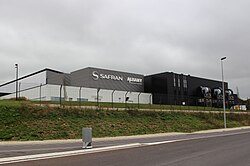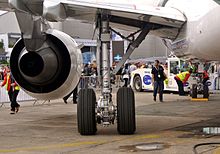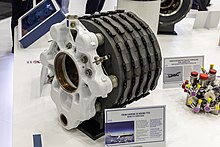Safran
 | |
 | |
| Type | Société Anonyme |
|---|---|
| Euronext: SAF CAC 40 Component | |
| Industry | Aerospace Defense |
| Predecessor | Snecma, Sagem |
| Founded | 2005 |
| Headquarters | , |
Key people | (CEO) Ross McInnes (Chairman)[1] |
| Products | Aircraft engines, equipment, and interiors, defence electronics, avionics, navigation system, communications systems, satellites |
| Revenue | |
| Total assets | |
| Total equity | |
Number of employees | 81,000 (09/30/2020)[3] |
| Subsidiaries | Safran Aircraft Engines Safran Electronics & Defense Safran Helicopter Engines Safran Landing Systems Safran Seats ArianeGroup (50 %) |
| Website | www |
Safran S.A. is a French multinational aircraft engine, rocket engine, aerospace-component and defense corporation. It was formed by a merger between the aircraft and rocket engine manufacturer and aerospace component manufacturer group SNECMA and the security company SAGEM in 2005. In 2018 Safran took control of Zodiac Aerospace, significantly expanding its aircraft equipment activities. Its headquarters are located in Paris. Employing over 95,000 people and generating 24.64 billion euros in sales in 2019, Safran operates in the aircraft propulsion and equipment, space and defense markets. The company is listed on the Euronext stock exchange and is part of the CAC 40 and Euro Stoxx 50 indices.[4]
Name[]
The name Safran was chosen from 4,250 suggestions, including 1,750 proposed by employees.[5][6] As a holding company for many subsidiaries, the name was deemed suitable for the suggestion of direction, movement, and strategy. Safran translates as rudder blade and as saffron, which the company highlights as one of the catalysts for early international trade.[7]
History[]
This section needs expansion. You can help by . (June 2014) |
Origins[]
In 1905 Louis Seguin created the company Gnome.[8] Production of the first rotary engine for airplanes, the Gnome Omega, started in 1909.[8] This company merged with the Le Rhône, a company created in 1912 by Louis Verdet, to form the Gnome et Rhône engine company.[8] Gnome & Rhône was nationalized in 1945, creating Snecma.[8] In 2000, this company gave its name to the “Snecma Group”, and carried out a number of acquisitions to form a larger group with an array of complementary businesses.[8]
Sagem (Société d’Applications Générales de l’Electricité et de la Mécanique) was created in 1925 by Marcel Môme.[8] In 1939, Sagem entered the telephone and transmissions market by taking control of Société anonyme des télécommunications (SAT).[citation needed] It acquired Société de Fabrication d’Instruments de Mesure (Sfim), a measurement instrument specialist, in 1999.[citation needed] However, by 2008 Sagem Mobile and Sagem Communications had been sold.[citation needed] Sagem Mobile became Sagem Wireless in January 2009.[citation needed]
Safran Group[]
The Safran Group was created on May 11, 2005, with the merger of Snecma and Sagem SA.[8]
In June 2014, Arianespace CEO announced that European efforts to remain competitive in response to SpaceX's recent success have begun in earnest. This included the creation of a new joint venture company from Arianespace's two largest shareholders: the launch-vehicle producer Airbus and engine-producer Safran.[9]
By May 2015, Safran had created with Airbus Group a launcher joint venture called Airbus Safran Launchers.[10] This entity is currently developing the Ariane 6 launch vehicle for initial flights in the 2020s.[11]
In January 2017, Safran initiated a takeover of the aircraft interior supplier Zodiac Aerospace to create the third largest aerospace supplier with $22.5 billion revenue, behind United Technologies with $28.2 billion and GE Aviation with $24.7 billion; the new group will be 92,000-employee strong, with 48% of its business in aircraft systems and equipment, from landing gears to seats, 46% in propulsion and 6% in defense.[7]
In May 2017, Safran announced the completion of the sale of its identity and security activities to Advent International for Euro 2.4 billion.[12]
In February 2018, Safran took control of Zodiac Aerospace, significantly expanding its aircraft equipment activities. Zodiac Aerospace has 32,500 employees and generated sales of 5.1 billion euros for its fiscal year ended August 31, 2017.[4]
On June 4, 2018, Boeing and Safran announced their 50-50 partnership to design, build and service Auxiliary Power Units after regulatory and antitrust clearance in the second half of 2018.[4] This could threaten the dominance of Honeywell and United Technologies.[13]
Group organization[]
The Safran group is divided into three main branches:[14]
Aerospace Propulsion[]

The aerospace propulsion branch groups all operations concerning the propulsion of aeroplanes, helicopters, missiles, and launchers, for the civil aviation, military aviation, and space markets: design, production, marketing, testing, maintenance, repair, and overhaul (MRO).
- Safran Aircraft Engines (formerly Snecma Moteurs)
- Commercial & military engines, liquid propulsion for space launchers
- Safran Helicopter Engines
-
- Components for aircraft and rocket engines
-
- Power transmissions for aircraft engines
- ArianeGroup
- Solid rocket motors for launchers, strategic and tactical missiles
- Thermostructural composite materials
At the October 2018 NBAA convention, Safran presented its ENGINeUS electric motor range up to 500 kW (670 hp) designed for electric aircraft, starting with a 45 kW (60 hp) one with integrated control electronics, with an energy efficiency of over 94% and a power-to-weight ratio of 2.5 kW / kg at 2,500rpm and 172 N⋅m (127 lbf⋅ft) of torque, for a 18 kg (40 lb) weight with the controller, 12 kg (26 lb) without.[15] Flight-testing may happen in 2019 or 2020.[16]
Other subsidiaries[]
- Safran Test Cells, Inc.
- Smartec
- SMA Engines
- Snecma Services Brussels
- Snecma Suzhou
- Snecma Xinyi Airfoil Castings
Aircraft Equipment, Defense and Aerosystems[]

The aircraft equipment branch groups all design, production, sales, and support operations for systems and equipment used by civil and military airplanes and helicopters.

- Safran Landing Systems
- Landing gear design, manufacture, and support
- Wheels and carbon brakes for mainline commercial jets
- Braking control and hydraulic systems
-
- Commercial airplane engine nacelles and thrust reversers
-
- Aircraft wiring and power distribution
- Safran Electronics & Defense
- Technologies and services in optronics, avionics, electronics and safety-critical software
-
- Equipment and systems in fluid management and security
-
- Engineering and consulting company
Other subsidiaries[]
- Globe Motors
- SLCA
- Sofrance
- Technofan Inc.
- OEMServices[17]
- Sagem Avionics
- Vectronix
- IdentoGO
Aircraft Interiors[]
-
- Cabin interiors
- Safran Seats
- Passenger and technical seats
-
- Cabin equipment and solutions focused on passenger comfort
Corporate affairs[]
[]
- As of 31 October 2020 [18]
- Public: 81.3%
- French state: 11.2%
- Employees: 7.4%
- Treasury shares: 0.1%
See also[]
- Musée aéronautique et spatial Safran - Museum managed by Safran containing French heritage aircraft engines
- List of aircraft engine manufacturers
References[]
- ^ "Olivier Andriès prend les commandes de Safran". Retrieved 3 January 2021.
- ^ "Safran : Very strong 2018 performance - Further growth and profitability improvement in 2019". Safran. Retrieved 27 February 2019.
- ^ "Safran at a glance". Safran. Retrieved 30 October 2020.
- ^ Jump up to: a b c d "Boeing, Safran Agree to Design, Build and Service Auxiliary Power Units" (Press release). June 4, 2018. Safran, Boeing
- ^ "Sagem et Snecma donnent naissance à " Safran "". Les Echos (in French). 2005-03-21. Retrieved 2019-08-27.
- ^ "Snecma and Sagem Merge, Changing Name to Safran". www.defense-aerospace.com. Retrieved 2019-08-27.
- ^ Jump up to: a b Thierry Dubois and Jens Flottau (Jan 20, 2017). "Tier 1 Consolidation Continues As Safran Takes Over Zodiac". Aviation Week & Space Technology.
- ^ Jump up to: a b c d e f g "Safran Timeline". Safran. Retrieved 2020-02-24.
- ^ Abbugao, Martin (2014-06-18). "European satellite chief says industry faces challenges". Phys.org. Retrieved 2014-06-19.
- ^ de Selding, Peter B. (2015-05-29). "Airbus Safran Agrees to $440 Million Ariane 6 Contribution". Space News. Retrieved 12 June 2015.
- ^ de Selding, Peter B. (2015-04-03). "Desire for Competitive Ariane 6 Nudges ESA Toward Compromise in Funding Dispute with Contractor". Space News. Retrieved 8 April 2015.
- ^ "Completion of the sale of Safran's identity and security activities" (Press release). Safran. 31 May 2017.
- ^ Stephen Trimble (June 4, 2018). "Boeing and Safran partner to disrupt APU market". Flightglobal.
- ^ "Safran modifies the operational management of its equipment activities. New presentation of segment information at June 30, 2019 ". July 1, 2019.
- ^ "Safran unveils an electric motor from its ENGINeUS range, designed for future hybrid and electric aircraft" (Press release). Safran. October 15, 2018.
- ^ Max Kingsley Jones (17 Oct 2018). "NBAA: Safran shows off electric power technology". flightglobal.
- ^ "OEMServices Shareholders". OEMServices.
- ^ "Capital structure and voting rights". Safran.
External links[]
- Safran Group
- Aerospace companies of France
- Companies based in Paris
- Manufacturing companies established in 2005
- Defence companies of France
- French companies established in 2005
- French brands
- CAC 40
- Companies listed on Euronext Paris
- Multinational companies headquartered in France
- Companies in the Euro Stoxx 50
- Government-owned companies of France
- Companies formed by merger